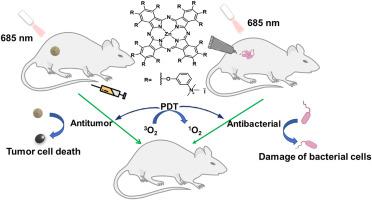Journal of Photochemistry and Photobiology B: Biology ( IF 3.9 ) Pub Date : 2020-11-16 , DOI: 10.1016/j.jphotobiol.2020.112086 Bing-De Zheng , Shun-Li Li , Zhen-Liang Huang , Ling Zhang , Hao Liu , Bi-Yuan Zheng , Mei-Rong Ke , Jian-Dong Huang

|
With a view to developing highly efficient photosensitizers for both antitumor and antimicrobial photodynamic therapies, herein, we reported a super cationic zinc(II) phthalocyanine (Pc4), which was prepared through the quaternization of the N, N-dimethyl-3-aminophenoxyl-hexadeca-substituted precursor Pc3. Meanwhile, two disubstituted analogues (Pc1 and Pc2) were also prepared as controls. The cationic Pc2 and Pc4 had higher photoactivities including fluorescence and singlet oxygen than the neutral counterparts Pc1 and Pc3, probably because of the inhibition of intramolecular charge transfer (ICT) effect of the amino groups. With the bulky steric effect and high hydrophilicity, Pc4 presented non-aggregated behavior in aqueous solutions. Therefore, it exhibited the highest in vitro photodynamic activity toward HepG2 cancer cells with an IC50 value as low as 0.04 μM. Furthermore, Pc4 showed a highly efficient in vivo PDT effect on H22 tumor-bearing mice with 98.7% tumor growth inhibition. In addition, Pc4 also exhibited an excellent in vitro and in vivo photodynamic inactivation against S. aureus. The results indicate that the non-aggregated hexadeca-cationic Pc4 could serve as a promising photosensitizer for both antitumor and antimicrobial photodynamic therapies.
中文翻译:

非聚集的带有十六烷基阳离子的酞菁锌(II),用于抗肿瘤和抗菌光动力疗法
为了开发用于抗肿瘤和抗微生物光动力疗法的高效光敏剂,在本文中,我们报道了一种超级阳离子锌酞菁锌(Pc4),该酞菁锌是通过N,N-二甲基-3-氨基苯氧基-十六烷基取代的前体Pc3。同时,还制备了两个双取代的类似物(Pc1和Pc2)作为对照。阳离子Pc2和Pc4具有比中性对应物Pc1和Pc3高的光活性,包括荧光和单线态氧,可能是因为抑制了氨基的分子内电荷转移(ICT)效应。具有庞大的空间效应和高亲水性,Pc4在水溶液中呈现非聚集行为。因此,它对HepG2癌细胞表现出最高的体外光动力活性,其IC 50值低至0.04μM。此外,Pc4对H22荷瘤小鼠表现出高效的体内PDT效应,并具有98.7%的肿瘤生长抑制率。此外,Pc4还表现出优异的针对金黄色葡萄球菌的体外和体内光动力灭活作用。结果表明,非聚集的十六烷基阳离子Pc4可以用作抗肿瘤和抗菌光动力疗法的有前途的光敏剂。











































 京公网安备 11010802027423号
京公网安备 11010802027423号